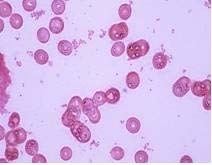Scientific name Haemophilus Rank Genus | Family Pasteurellaceae Higher classification Pasteurellaceae Phylum Proteobacteria | |
 | ||
Lower classifications Haemophilus influenzae | ||
Haemophilus influenzae and bacterial meningitis microbiology lectures
Not to be confused with Haemophilia
Contents
- Haemophilus influenzae and bacterial meningitis microbiology lectures
- Haemophilus influenzae introduction
- Metabolism
- References
Haemophilus is a genus of Gram-negative, pleomorphic, coccobacilli bacteria belonging to the Pasteurellaceae family. While Haemophilus bacteria are typically small coccobacilli, they are categorized as pleomorphic bacteria because of the wide range of shapes they occasionally assume. These organisms inhabit the mucous membranes of the upper respiratory tract, mouth, vagina, and intestinal tract. The genus includes commensal organisms along with some significant pathogenic species such as H. influenzae—a cause of sepsis and bacterial meningitis in young children—and H. ducreyi, the causative agent of chancroid. All members are either aerobic or facultatively anaerobic.
Haemophilus influenzae introduction
Metabolism
Members of the Haemophilus genus will not grow on blood agar plates, as all species require at least one of these blood factors for growth: hemin (factor X) and/or nicotinamide adenine dinucleotide (factor V). They are unable to synthesize important parts of the cytochrome system needed for respiration, and they obtain these substances from the heme fraction, known as the X factor, of blood hemoglobin. The culture medium must also supply the cofactor nicotinamide adenine dinucleotide (from either NAD+ or NADP+), which is known as the V factor. Clinical laboratories use tests for the requirement of the X and V factors to identify the isolates as Haemophilus species.<
Chocolate agar is an excellent Haemophilus growth medium, as it allows for increased accessibility to these factors. Alternatively, Haemophilus is sometimes cultured using the "Staph streak" technique: both Staphylococcus and Haemophilus organisms are cultured together on a single blood agar plate. In this case, Haemophilus colonies will frequently grow in small "satellite" colonies around the larger Staphylococcus colonies because the metabolism of Staphylococcus produces the necessary blood factor byproducts required for Haemophilus growth.
